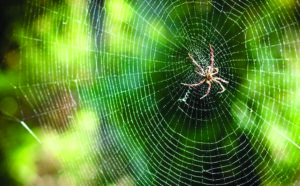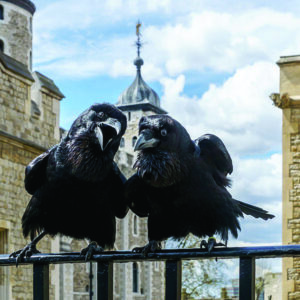By Dr. Beth Leermakers
Tis the season for outdoor Halloween decorations. In my neighborhood, that means a lot of spiders crawling up spider webs. Other than looking spooky and creepy, what do spiders have to do with Halloween? Read on for a few interesting facts and legends about spiders and ravens, another common Halloween animal.
Spiders. Considered to have supernatural qualities, spiders have intrigued people for centuries. In the Middle Ages, spiders were linked to witchcraft because people believed the mystical arachnids used magic to weave such intricate webs. According to folklore, spiders and their spinning and web-weaving abilities help witches cast spells. As such, spiders are familiar witches’ companions that help them perform magic. Spiders may be associated with Halloween in part because it’s during the fall season that orb weaver spiders are mature enough to begin weaving webs, both inside and outside our houses.

Photos courtesy of WikiMedia Commons
According to one superstition, if a spider falls into a candle-lit lamp and is consumed by the flame, a witch is nearby.
However, one medieval superstition states that if you see a spider on Halloween, the spirit of a loved one is watching over you. So spiders may not be so bad after all. Despite their scary appearance, only two spiders in the United States — the black widow and brown recluse — have venom that’s strong enough to be harmful to people.
Ravens. Ravens have been considered symbols of evil or death by many cultures, long before Edgar Allen Poe made them infamous in 1845. Ravens are associated with death because of their ebony color, distinctive “caw” sound and scavenger nature. The color black is linked with death and sin in Western culture. Because ravens eat carrion (dead animals), Celtic people associated them with death, war and the battlefield. The ominous birds feasted on the remains of soldiers killed in battle.
According to Swedish folklore, ravens’ harsh caws were considered to be voices of murdered people who didn’t have a proper Christian burial. Germans believed ravens could locate the souls of the dead and witches rode on the birds’ backs instead of on broomsticks. Ravens sit on perches near witches, seeing everything that happens. These birds served as witches’ messengers, carrying magic across great distances and gathering secrets to bring back to the witches.

According to legend, Britain is secure as long as ravens remain at the Tower of London. King Charles II, who ruled in the mid-1600s, first claimed, “The Tower itself will crumble to dust and a great harm will befall the kingdom” if anything happens to the ravens. Apparently the king’s astronomer had complained about the ravens interfering with his observatory work in the White Tower.
The king ordered the ravens to be destroyed, only to be told that the White Tower would fall, and a great disaster would occur in the kingdom if the ravens left. Charles II wisely proclaimed that the unkindness (group of ravens) be kept at the fortress at all times to prevent disaster.
During World War II, when the numbers declined to just a single raven guard, Winston Churchill ordered the flock be increased to at least six at all times. A ravenmaster cares for the birds, feeding them meat (mostly rabbit) from a local market and occasional treats — biscuits dipped in blood. The ravens are the guardians of the tower, tasked with patrolling the fortress. During World War II the royal ravens were used as spotters for bombs and planes in the Blitz.
The ravens can be fired for neglecting their duties or misbehaving. In 1986 George, who had served for 11 years, was dismissed for “unsatisfactory” conduct after destroying five TV aerials in a week. He was banished to Wales. Hugine and Jackie were fired in 1996 after “going rogue.” The pair refused to settle down after their mating period and were dismissed for “conduct unbecoming to Tower residents.”
In January 2021, Merlina, the queen raven, disappeared from the Tower, bringing its unkindness down to seven birds. Since then, two young ravens have been chosen to protect the kingdom, with the other remaining birds (Poppy, Erin, Jubilee, Rocky, Harris, Gripp and Georgie).
The ravenmaster named the male chick Edgar, after Edgar Allen Poe, but the British public voted on the name of the female. The female was named Branwen — after a goddess from Celtic mythology.
Ravens are well suited to guard the Tower. They are highly intelligent birds who make and use tools, plan for the future, barter and even play games like hide-and-seek. Ravens can mimic animal and bird calls and even human voices.
Happy Halloween!
